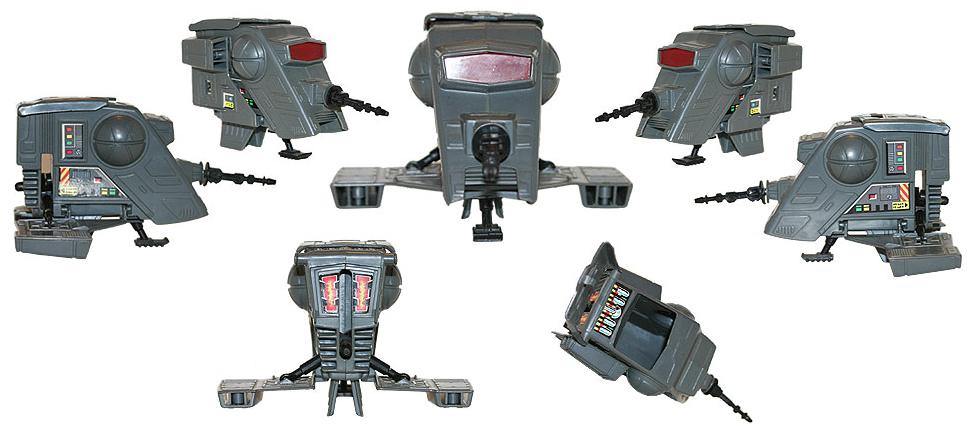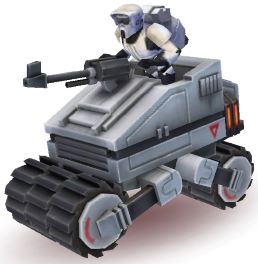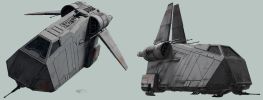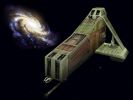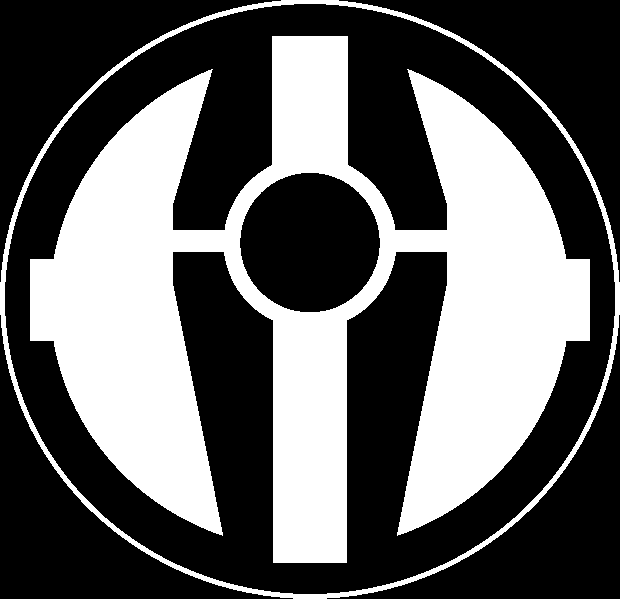 Palpatinian Syhith Order. | 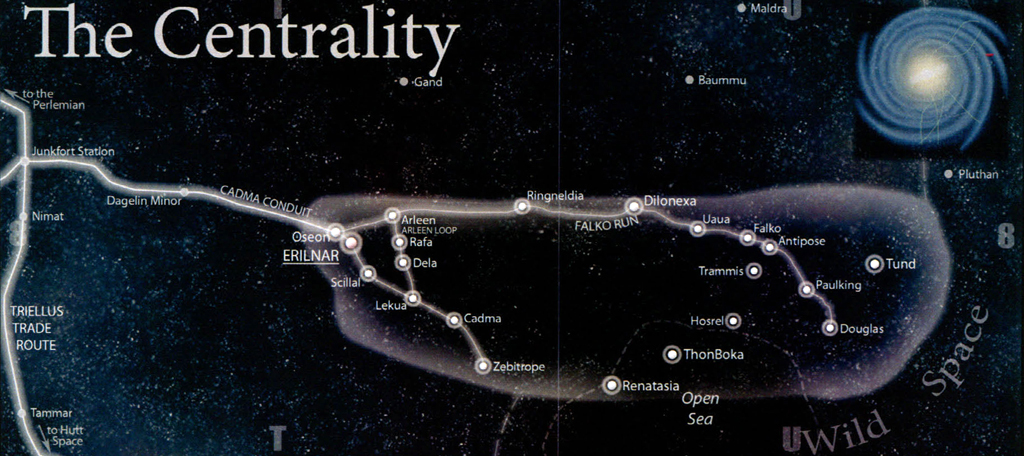 Centrality. | ||||||||||||
|---|---|---|---|---|---|---|---|---|---|---|---|---|---|
| The INT-4 "Interceptor" was a scout craft developed by the Centrality but copied by Palpatinian affiliated engineers and built by the millions for sale to the Galactic Army as "flying machinegun nests" to fit inside the passenger The name "Interceptor" actually comes for the designation; Because the Empire never accepted the INT-4 into formal inventory, it was never named. Characteristics: Costing only 22,000credit each, the 8 ft long, 4/10 ft wide, and 6 ft high attackers weighed in at only 3 tons. At 381 miles per hour, they were slow by any militry standard.They were powered by twin SFS-41 and equipped with very heavy shielding for such a light craft. The titanium/steel alloy also increased the survivability of the craft. The primary sensor, targeting, and navigation system was the fairly cheap SFS-431, and only basic avionics and countermeasures were included to save space, weight, and therefore cost. Since the concept was for a flying machinegun nest, the only armament was a single heavy blaster cannon, operated by the single pilot; No passengers were possible (at that, the pilot was fairly cramped). The craft could also carry a few days worth of food, water, etc., if the pilot was shot down. Short range voice-only radios provided the only communications, although basic hologram or viewscreen capabilities could be included later if the buyers so chose. A simple ejector seat was also included, though the craft proved incredibly sturdy; In the biggest battle ever to include INT-4's (the Battle Of Hoth, 3 ABY), over 100 INT-4's entered the fray. Only 10 were shot down, after multiple hits from the heaviest firepower the rebels could muster- Each INT-4 was hit at least twice by ion cannons nominally capable of disabling a Star Destroyer. History: A version of the INT-4 was employed within the Centrality as early as 3 BBY, in events surrounding the Battle of ThonBoka; Several squadrons of guarding the secret Imperial Navy research base on the surface of Hosrel XI were sent to destroy once and for all the Oswaft. Outside the empire, the INT-4 became fairly common (especially after the fall of the Palpatinian Order) as an Interceptor and its original role, a flying machinegun nest. They were used extensively from the Rise of the Empire in to the formation of New Republic, and are still in limited use today (though most now are historic units and static displays). The REF bought a few for testing, but these are automated sentries only. They are generally identified with the Galactic Empire, Renatasian Confederation, New Republic, and Private Militry Contractors. Influence: The INT-4 hasn't had much influence at all in the galaxy, or abroad either. They are too lightly armed and difficult to maneuver to be effective ground attackers, too slow to be surveillance craft, too small a cargo to carry anything worth the cost in flight-hours, and too expensive to convert to automated or semi-automated designs. They are, however, incredibly tough little craft- During the Battle of Endor, several hundred were fitted to rudimentary automated flight (mostly using rebuilt droid brains) and used as flying bombs. It was one of these that destroyed the Super Star Destroyer EXECUTOR'S bridge shields, clearing the way for Arvel CRYNYD'S suicide run into her bridge, sending her careening out of control (and right into DEATH STAR II). They did have some influence in other platforms (see Derivatives And Semi-Derivatives), but even this was significantly limited, and many would argue the 'influence' was nothing of the sort. Flight Dynamics: A curious effect of the folding-wing design allows more experienced pilots to lift and lower the wings in flight to increase or decrease turn radius, a feat never before nor after in an atmospheric craft in this fashion until the UGC's Veritechs appeared, and without effecting speed (never before done by any craft, and only replicated since a few times). Ownership Dispute: The INT-4 was originally developed by and for the Centrality; Export was not intended. Centrality disputes the claim made to development by the Palpatinians, a dispute the Geh 'Dai have generally supported, but that the UGC ruled to be a veneer of independence. No claim to objection was made until the UGC stamped it Palpatinian, and the Centrality did receive support (if limited) from the Palaptinians during their rulership; Further, the Palpatinians claim they in fact did pay for the blueprints. The issue is far from semantic; Claimant of development entitles the developer to demand compensation. Indeed, the UGC has a very large fund of money they contend rightfully belongs to the Palpatinian Order (that the Order won't claim since it would acknowledge the UGC's rightful existence, which the Order denies). If Centrality sold the blueprints as the Palpatinians claim, the Order can claim the compensation; If the Order stole it as is alleged, the Palpatinians would owe Centrality, in addition to loosing any other future claims. The UGC acknowledged the Order obtained the blueprints under "unusual circumstances" when the then ruler of a Centrality district sold the blueprints without proper authorization- But he sold the blueprints, the Order didn't "steal" them. As a result, the UGC Courts ruled the blueprints to be mutual property, and that claims against it had to be split. Due to Palpatinian recalcitrance, the UGC itself eventually ruled that unclaimed compensations by the Order would transfer to the joint owners after ten years, making Centrality and the Geh 'Dai Order eligible for funds that would have gone to the Palpatinians. This in no way effects sole claims, such as the TIE Series or AT-ST/AT-AT craft, however, and that money continues to sit in a bank account collecting interest- Interest that will revert to the UGC after 1,000 years. It has been explicitly stated repeatedly that the UGC is attempting to use this to draw the Palpatinian Order in particular in for dialog, but to date these effects have proven futile. Derivatives And Semi-Derivatives: The INT-4 is believed by most to have been the inspiration for the Terex and probably the more practical Preox-Morlana's Corporate Tactical Forces' RK-392 Mobile Tac-Pod troop lander, in addition to the MTV-7
None of these proved terribly incredible, and certainly no better than whatever preceded it, though the Tac-Pod was fully capable of serving as a troop/cargo transport. No operationally ready example of any of these can be found, and only a few dozen parts of the MTV-7 have ever been recovered (as too few were ever made to begin with), none of which could be combined to give researchers a full example to study. The least unsuccessful of these "decedents" was the MLC-2 when they were converted to automated systems as designated stay-behind and semi-intelligent land mines against robots, though the INT-4's influence in this respect is highly dubious. Overall, the best that anyone can offer is photos and video of some of these, and computer reconstruction of the Terex (as no known images still exist). Critical Analysis: The INT-4 is junk, but highly effective junk. For all intents and purposes, it's impossible to shoot down. But it also is too inflexible and lightly armed to be effective against anything more than infantry. The design doesn't allow the weapons system to be upgraded to any appreciable degree, and external weaps are impracticable due to the wing design. Additionally, the craft requires a very heavy ground crew; The features intended to make it more flexible on the ground (over simplification) actually had the opposite effect since the equipment breaks down too easily. The craft also needs support from Vehicle Maintenance Energizer and power droids, even when on the ground. The final effect was a 3-man ground crew for every 2 craft, when the universal standard is 11 ground crew for every 100 craft. | |||||||||||||
